Identifying and Zoning Key Areas of Ecological Restoration for Territory in Resource-Based Cities: A Case Study of Huangshi City, China
Abstract
1. Introduction
2. Material and Methods
2.1. Study Area
2.2. Data Sources
2.3. Methods
2.3.1. Ecological Environment Sensitivity Analysis
Selection of Assessment Factors
Establishment of Indicator System
Ecological Sensitivity Calculation
2.3.2. Analysis of Spatiotemporal Changes in Habitat Quality
InVEST Model
Rate of Change of Habitat Quality
2.3.3. Ecological Restoration Zoning
3. Results
3.1. Ecological Sensitivity Analysis
3.1.1. Univariate Sensitivity Analysis
3.1.2. Integrated Sensitivity Analysis
3.2. Analysis of Spatiotemporal Changes in Habitat Quality
3.3. Ecological Restoration Zoning
3.4. Diagnosis of Ecological Problems and Restoration Strategies
4. Discussion
4.1. Result Discussion and Feasibility
4.2. Limitations and Future Work
5. Conclusions
- (1)
- The overall distribution trend of ecological sensitivity in Huangshi is toward high sensitivity mountain forests and other regions with dense vegetation and wetlands. There was a dense distribution of mines in the city, showing the common feature of zoning by sensitivity in resource-based cities.
- (2)
- In the period from 1980 to 2018, the habitat quality index of Huangshi was good, with a slight decreasing trend. The simulated habitat quality distribution was consistent with the region-dominated land cover type. The urban built-up areas and key mining areas in the north of Huangshi showed low quality and continuously decreasing quality, whereas woodland, grassland, and water areas in the south of Huangshi had a higher habitat quality index and lower ecological conservation stress.
- (3)
- Huangshi was partitioned into 14 land space ecological restoration zones, forming a spatial pattern with natural protected areas as the priority protection areas, mining areas as the key restoration areas, and natural protected areas and mining areas as the general restoration areas.
- (4)
- During the period of 1980–2018, the water management of Huangshi generally improved, and the habitat quality improved, which indicates that the water pollution control in Huangshi had a positive effect.
Author Contributions
Funding
Institutional Review Board Statement
Informed Consent Statement
Data Availability Statement
Acknowledgments
Conflicts of Interest
References
- Sun, X.H.; Zheng, H.; Yu, R.Q.; Long, R. The transformation and upgrading of resource-based cities:pressure measurement and direction selection. China Popul. Resour. Environ. 2020, 30, 54–62. (In Chinese) [Google Scholar]
- Qu, Y.B.; Jiang, G.H.; Li, Z.T.; Tian, Y.Y.; Wei, S.W. Understanding rural land use transition and regional consolidation implications in China. Land Use Policy 2019, 82, 742–753. [Google Scholar] [CrossRef]
- Leopold, A. Wilderness as a form of land use. J. Land Public Util. Econ. 1925, 1, 398–404. [Google Scholar] [CrossRef]
- Mateos, D.M.; Alberdi, A.; Morrin, E.; Putten, W.; Montoya, D. The long-term restoration of ecosystem complexity. Nat. Ecol. Evol. 2020, 4, 676–685. [Google Scholar] [CrossRef] [PubMed]
- Camarretta, N.; Harrison, P.A.; Bailey, T.; Potts, B.; Lucieer, A.; Davidson, N.; Hunt, M. Monitoring forest structure to guide adaptive management of forest restoration: A review of remote sensing approaches. New For. 2020, 51, 573–596. [Google Scholar] [CrossRef]
- Lina, P.; Lovisa, L.; Henrik, P.; Aneliza, M.; Francesca, P.; Su, X.; Christer, N. Facets and scales in river restoration: Nestedness and interdependence of hydrological, geomorphic, ecological, and biogeochemical processes. J. Environ. Manag. 2020, 265, 110288. [Google Scholar] [CrossRef]
- Hoylman, Z.H.; Jencso, K.G.; Hu, J.; Holden, Z.A.; Allred, B.; Dobrowski, S.; Robinson, N.; Martin, J.S.; Affleck, D.; Seielstad, C. The Topographic Signature of Ecosystem Climate Sensitivity in the Western United States. Geophys. Res. Lett. 2019, 46, 14508–14520. [Google Scholar] [CrossRef]
- Zhao, Y.; Wang, Z.G.; Sun, B.P.; Zhang, C.; Ji, Q.; Feng, L.; Zhao, Q.K. A primary study on scheme of soil and water conservation regionalization in China. Acta Geogr. Sin. 2013, 68, 307–317. (In Chinese) [Google Scholar]
- Liu, G.B.; Wang, B.; Wei, W.; Cai, J.J.; Chen, Y.M.; Bi, H.X.; Liu, G.Q.; Wei, A.Z. Technique and demonstration of water and soil loss comprehensive harness on the loess Plateau. Acta Ecol. Sin. 2016, 36, 7074–7077. (In Chinese) [Google Scholar] [CrossRef]
- Hou, H.P.; Zhang, S.L.; Yan, Y.; Guo, S.Y.; Dun, D.G.; Jin, Y.J. Study on ecological landscape restoration in mining areas based on RS and GIS: A case of Xuzhou Northern coal mining area. China Land Sci. 2009, 23, 62–67. (In Chinese) [Google Scholar]
- Yang, Y.P.; Luo, F.Z.; Wang, B.J. Research on ecological restoration planning of coal mine wasteland based on permaculture design. J. Nat. Resour. 2018, 33, 1080–1091. (In Chinese) [Google Scholar]
- Liu, Y.; Zhu, W.B.; Han, Y.; Li, S.C. Regionalization of water conservation function of Beijing-Tianjin-Hebei Area based on SOFM neural network. Res. Environ. Sci. 2015, 28, 369–376. (In Chinese) [Google Scholar] [CrossRef]
- Wang, X.H.; Zhang, X.; Mou, X.J.; Zhu, Z.X. Discussion on the Planning of land spatial ecological restoration. Environ. Prot. 2019, 47, 36–38. (In Chinese) [Google Scholar] [CrossRef]
- Qin, Y.; Yang, Z.F.; Yang, W. Ecological risk assessment for water scarcity in China’s Yellow River Delta Wetland. Stoch. Environ. Res. Risk. Assess. 2011, 25, 697–711. [Google Scholar] [CrossRef]
- Su, S.L.; Li, D.; Yu, X.; Zhang, Z.H.; Zhang, Q.; Xiao, R.; Zhi, J.J.; Wu, J.P. Assessing land ecological security in Shanghai (China) based on catastrophe theory. Environ. Res. Risk. Assess 2011, 25, 737–746. [Google Scholar] [CrossRef]
- Peng, J.; Pan, Y.J.; Liu, Y.X.; Zhao, H.J.; Wang, Y.L. Linking ecological degradation risk to identify ecological security patterns in a rapidly urbanizing landscape. Habitat Int. 2018, 71, 110–124. [Google Scholar] [CrossRef]
- Su, S.L.; Xiao, R.; Jiang, Z.L.; Zhang, Y. Characterizing landscape pattern and ecosystem service value changes for urbanization impacts at an eco-regional scale. Appl. Geogr. 2012, 34, 295–305. [Google Scholar] [CrossRef]
- Cui, L.L.; Li, G.S.; Liao, H.J.; Ouyang, N.L.; Zhang, Y. Integrated Approach Based on a Regional Habitat Succession Model to Assess Wetland Landscape Ecological Degradation. Wetlands 2015, 35, 281–289. [Google Scholar] [CrossRef]
- Liu, X.H.; Liu, L.; Peng, Y. Ecological zoning for regional sustainable development using an integrated modeling approach in the Bohai Rim, China. Ecol. Model. 2017, 353, 158–166. [Google Scholar] [CrossRef]
- Wang, G.L.; Yang, D.G.; Xia, F.Q.; Zhong, S.R.; Xiong, C.H. Three Types of Spatial Function Zoning in Key Ecological Function Areas Based on Ecological and Economic Coordinated Development: A Case Study of Tacheng Basin, China. Chin. Geogr. Sci. 2019, 29, 689–699. [Google Scholar] [CrossRef]
- Yu, J.; Yao, S.Z.; Chen, R.Q.; Zhu, K.J.; Yu, L.D. A quantitative integrated evaluation of sustainable development of mineral resources of a mining city: A case study of Huangshi, Eastern China. Resour. Policy 2005, 30, 7–19. [Google Scholar] [CrossRef]
- Gao, L.; Ma, C.M.; Wang, Q.X.; Zhou, A.G. Sustainable use zoning of land resources considering ecological and geological problems in Pearl River Delta Economic Zone, China. Sci. Rep-UK 2019, 9, 16052. [Google Scholar] [CrossRef]
- Xie, Y.C.; Zhang, S.X.; Lin, B.; Zhao, Y.J.; Hu, B.Q. Spatial zoning for land ecological consolidation in Guangxi based on the ecosystem services supply and demand. J. Nat. Resour. 2020, 35, 217–229. (In Chinese) [Google Scholar] [CrossRef]
- Cao, W.; Wu, D.; Huang, L.; Liu, L.L. Spatial and temporal variations and signifcance identifcation of ecosystem services in the Sanjiangyuan National Park, China. Nature 2020, 10, 6151. [Google Scholar] [CrossRef]
- Li, F.; Xu, M.; Liu, Q.; Wang, Z.F.; Xu, W.J. Ecological restoration zoning for a marine protected area: A case study of Haizhouwan National Marine Park, China. Ocean Coast. Manag. 2014, 98, 158–166. [Google Scholar] [CrossRef]
- Ni, Q.L.; Hou, H.P.; Ding, Z.Y.; Li, Y.B.; Li, J.R. Ecological remediation zoning of territory based on the ecological security pattern recognition: Taking Jiawang district of Xuzhou city as an example. J. Nat. Resour. 2020, 35, 204–216. (In Chinese) [Google Scholar] [CrossRef]
- Zhu, Z.X.; Wang, X.H.; Rao, S.; Zhang, X.; Li, C.H.; Li, C.H.; Li, D.H.; Mou, X.J. Study of the method on zoning of territorial space ecological protection and rehabilitation and case of Chengde. Environ. Ecol. 2020, 2, 1–7. (In Chinese) [Google Scholar]
- Song, W.; Han, Z.; Liu, L. Systematic diagnosis of ecological problems and comprehensive zoning of ecological conservation and restoration for an integrated ecosystem of mountains-rivers-forests-farmlands-lakes-grasslands in Shaanxi Province. Acta Ecol. Sin. 2019, 39, 8975–8989. (In Chinese) [Google Scholar]
- Bi, P.Y. Research on Sustainable Development Abilities of Mining Cities in China. Ph.D. Thesis, China University of Geosciences, Beijing, China, 2010. [Google Scholar]
- Ouyang, Z.Y.; Wang, X.K.; Miao, H. China’s eco-environmental sensitivity and its spatial heterogeneity. Acta Ecol. Sin. 2000, 1, 10–13. (In Chinese) [Google Scholar]
- Wang, X.M.; Bian, Z.F. The implications of ecological sensitivity on exploitation of unutilized land: A case study in Ji’nan City, China. Procedia Environ. Sci. 2011, 10, 275–281. [Google Scholar] [CrossRef]
- Han, F.; Chen, Z. Assessment on ecological environment vulnerability of large coal mine: An example from Kailuan mining area, China. Int. Conf. Manuf. Eng. Environ. Eng. 2014, 84, 1461–1466. [Google Scholar] [CrossRef]
- Xiao, W.; Lv, X.J.; Zhao, Y.L.; Sun, H.X.; Li, J.Q. Ecological resilience assessment of an arid coal mining area using index of entropy and linear weighted analysis: A case study of Shendong Coalfield, China. Ecol. Indic. 2020, 109, 105843. [Google Scholar] [CrossRef]
- Zhou, J.; Fu, B.J.; Gao, G.Y.; Lv, Y.H.; Liu, Y.; Lv, N.; Wang, S. Effects of precipitation and restoration vegetation on soil erosion in a Semi-Arid environment in the loess plateau, China. Catena 2016, 137, 1–11. [Google Scholar] [CrossRef]
- Gathagu, J.N.; Mourad, K.A.; Sang, J. Effectiveness of Contour Farming and Filter Strips on Ecosystem Service. Water 2018, 10, 1312. [Google Scholar] [CrossRef]
- Gao, H.D.; Li, Z.B.; Li, P.; Jia, L.L.; Xu, G.C.; Ren, Z.P.; Pang, G.W.; Zhao, B.H. Capacity of soil loss control in the loess Plateau based on soil erosion control degree. J. Geogr. Sci. 2016, 26, 457–472. [Google Scholar] [CrossRef]
- Wu, J.H.; LI, J.W.; Zhu, H.R. Land Ecological Sensitivity Evaluation of Yan’an Based on Zonal Statistics of ArcGIS. J. Nat. Resour. 2011, 26, 1180–1188. (In Chinese) [Google Scholar] [CrossRef]
- Li, D.W.; Li, H.Q.; Lei, X.Q.; Lei, M.J. Ecological sensitivity in the upper Changjiang River with GIS technology and hierarchy analysis method. Resour. Environ. Yangtze Basin 2013, 22, 633–639. (In Chinese) [Google Scholar]
- Long, H.L. Land consolidation: An indispensable way of spatial restructuring in rural China. J. Geogr. Sci. 2014, 24, 211–225. [Google Scholar] [CrossRef]
- Zou, Z.H.; Yun, Y.; Sun, J.N. Entropy method for determination of weight of evaluating indicators in fuzzy synthetic evaluation for water quality assessment. J. Environ. Sci. 2006, 18, 1020–1023. (In Chinese) [Google Scholar] [CrossRef]
- Duan, Y.; Mu, H.L.; Li, N.; Li, L.L.; Xue, Z.Q. Research on comprehensive evaluation of low carbon economy development level based on AHP-entropy method: A case study of Dalian. Energy Procedia 2016, 104, 468–474. [Google Scholar] [CrossRef]
- Renard, K.G.; Foster, G.R.; Weesies, G.A.; Mccool, D.K.; Yoder, D.C. (Eds.) Predicting Soil Erosion by Water: A Guide to Conservation Planning With the Revised Universal Soil Loss Equation (RUSLE); Agricultural Handbook; U.S. Department of Agriculture: New York, NY, USA, 1997.
- Wischmeier, W.H. A soil erodibility nomograph for farmland and construction sites. J. Soil Water Conserv. 1971, 26, 189–193. [Google Scholar]
- Liu, B.Y.; Nearing, M.A.; Risse, L.M. Slope Gradient Effects on Soil Loss for Steep Slopes. Trans. ASAE 1994, 37, 1835–1840. [Google Scholar] [CrossRef]
- Cai, C.F.; Ding, S.W.; Shi, Z.H.; Huang, L.; Zhang, G.Y. Study of applying USLE and geographical information system IDRISI to predict soil erosion in small watershed. J. Soil Water Conserv. 2000, 14, 19–24. [Google Scholar] [CrossRef]
- Terrado, M.; Sabater, S.; Chaplin-Kramer, B.; Mandle, L.; Ziv, G.; Acuna, V. Model development for the assessment of terrestrial and aquatic habitat quality in conservation planning. Sci. Total Environ. 2016, 540, 63–70. [Google Scholar] [CrossRef] [PubMed]
- Zhu, J.F.; Ding, N.; Li, D.H.; Sun, W.; Xie, Y.J.; Wang, X.R. Spatiotemporal Analysis of the Nonlinear Negative Relationship between Urbanization and Habitat Quality in Metropolitan Areas. Sustainability 2020, 12, 669. [Google Scholar] [CrossRef]
- Cong, W.C.; Sun, X.Y.; Guo, H.W.; Shan, R.F. Comparison of the SWAT and InVEST models to determine hydrological ecosystem service spatial patterns, priorities and trade-offs in a complex basin. Ecol. Indic. 2020, 112, 106089. [Google Scholar] [CrossRef]
- Sharp, R.; Tallis, H.T.; Ricketts, T.; Guerry, A.D.; Wood, S.A.; ChaplinKramer, R. InVEST+ VERSION+ User’s Guide. 2012. Available online: https://naturalcapitalproject.stanford.edu/software/invest (accessed on 28 March 2021).
- Wu, C.F.; Lin, Y.P.; Chiang, L.C.; Huang, T. Assessing highway’s impacts on landscape patterns and ecosystem services: A case study in Puli Township, Taiwan. Landsc. Urban Plan. 2014, 128, 60–71. [Google Scholar] [CrossRef]
- Polasky, S.; Nelson, E.; Pennington, D.; Johnson, K.A. The Impact of Land-Use Change on Ecosystem Services, Biodiversity and Returns to Landowners: A Case Study in the State of Minnesota. Environ. Resour. Econ. 2011, 48, 219–242. [Google Scholar] [CrossRef]
- Yao, Y.Z. Evaluation and Dynamics Analysis of Habitat Quality Based on InVEST Model in the Sanjiang Plain. Master’s Thesis, University of Chinese Academy of Sciences, Changchun, China, 2017. [Google Scholar]
- Xie, Y.C.; Gong, J.; Zhang, S.X.; Ma, X.C.; Hu, B.P. Spatiotemporal change of landscape biodiversity based on InVEST model and re mote sensing technology in the Bailong River Watershed. Sci. Geogr. Sin. 2018, 38, 979–986. (In Chinese) [Google Scholar]
- Zhang, X.R.; Zhou, J.; Li, M.M. Analysis on spatial and temporal changes of regional habitat quality based on the spatial pattern reconstruction of land use. Acta Geogr. Sin. 2020, 75, 160–178. (In Chinese) [Google Scholar] [CrossRef]
- Aneseyee, A.B.; Noszczyk, T.; Soromessa, T.; Elias, E. The InVEST Habitat Quality Model associated with land use/cover changes: A qualitative case study of the Winike Watershed in the Omo-Gibe Basin, Southwest Ethiopia. Romote Sens. 2020, 12, 1103. [Google Scholar] [CrossRef]
- He, J.H.; Huang, J.L.; Li, C. The evaluation for the impact of land use change on habitat quality: A joint contribution of cellular auto-mata scenario simulation and habitat quality assessment model. Ecol. Model. 2017, 366, 58–67. [Google Scholar] [CrossRef]
- Wu, N.; Chen, H.F.; Feng, C.Y.; Jiang, H.Q.; Wu, W.J.; Li, D.Q.; Zhao, Y.C. Chen Spatio-temporal Evolution Characteristics of Habitat Quality Based on Land Cover Change in Anhui Province. Resour. Environ. Yangtze Basin 2020, 29, 1119–1127. (In Chinese) [Google Scholar] [CrossRef]
- Zhu, J.; Gong, J.; Li, J.Y. Spatiotemporal change of habitat quality in ecologically sensitive areas of eastern Qinghai-Tibet Plateau: A case study of the Hehuang Valley, Qinghai Province. Resour. Sci. 2020, 42, 991–1003. (In Chinese) [Google Scholar] [CrossRef]
- Hu, Z.Q.; Fu, Y.H.; Xiao, W.; Zhao, Y.L.; Wei, T.T. Ecological restoration plan for abandoned underground coal mine site in Eastern China. Int. J. Min. Reclam. Environ. 2015, 29, 316–330. [Google Scholar] [CrossRef]
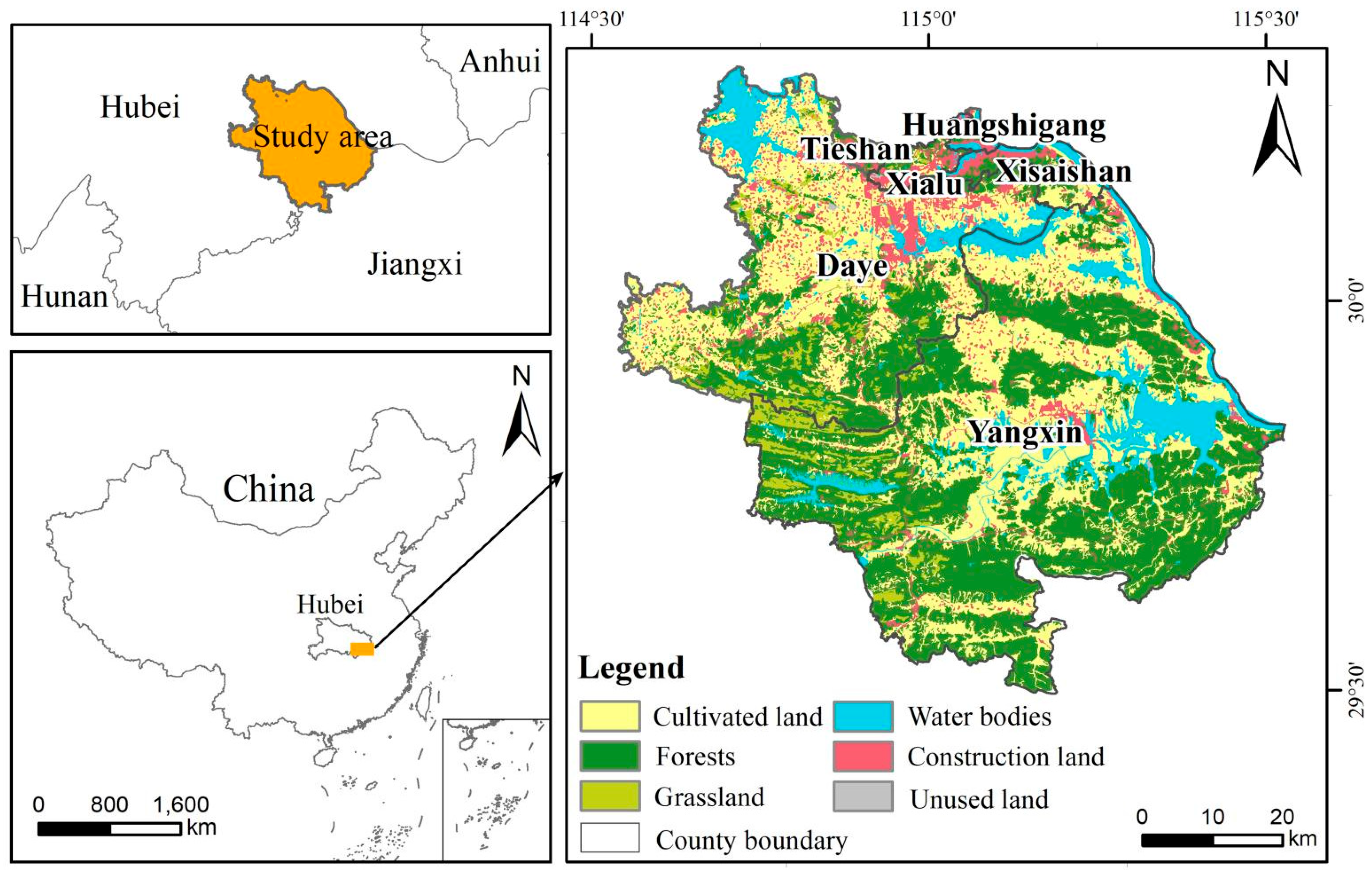
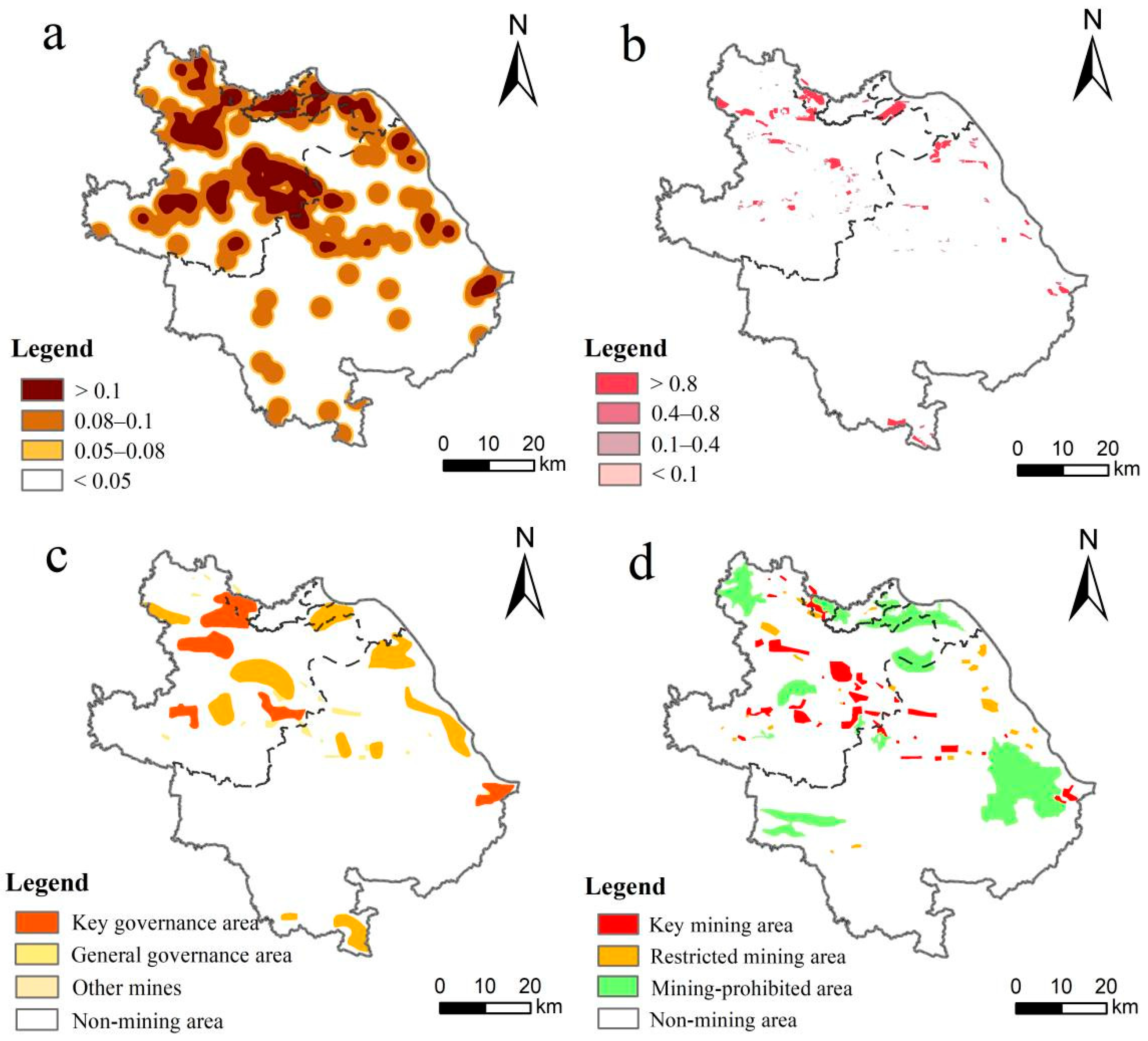



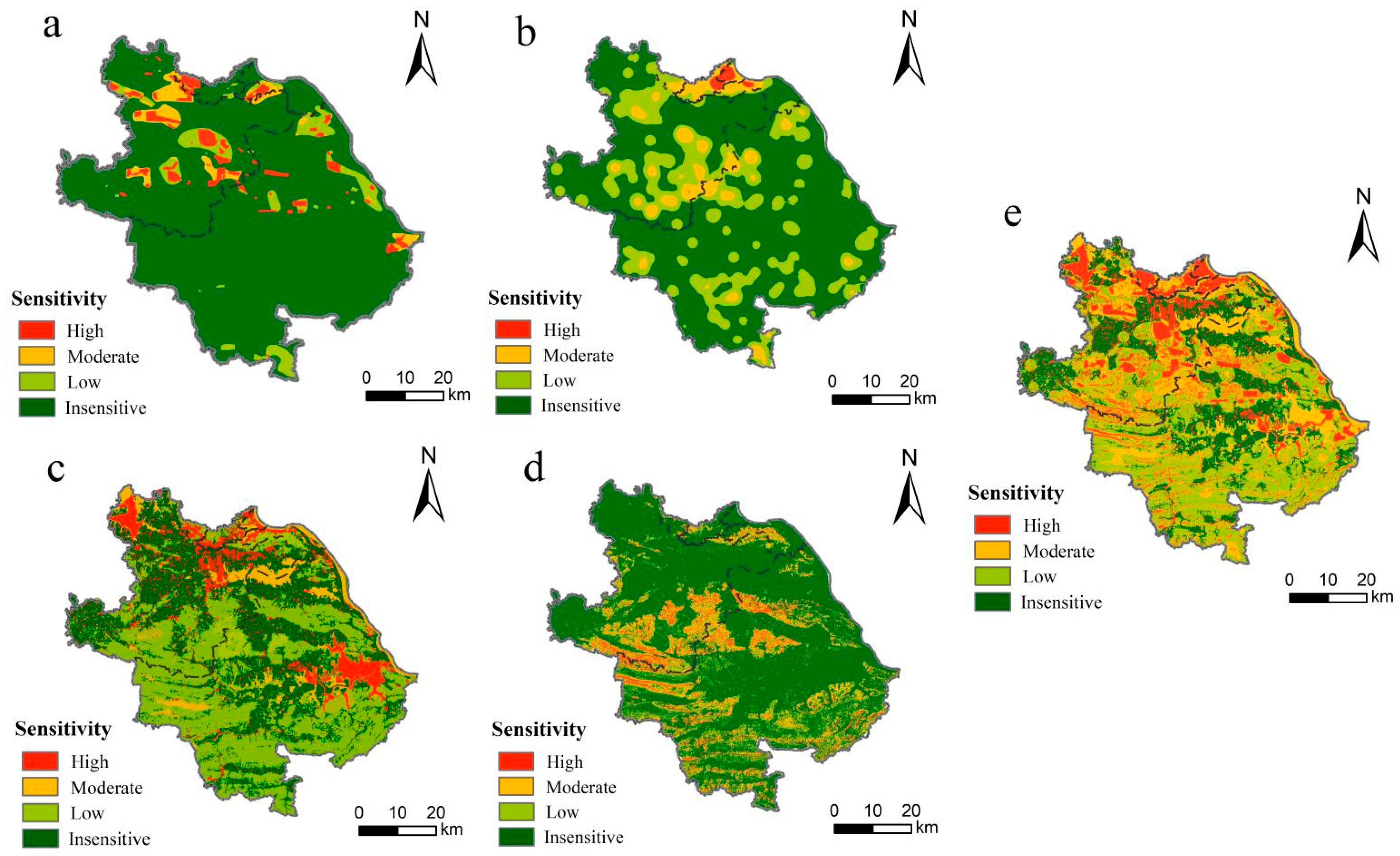
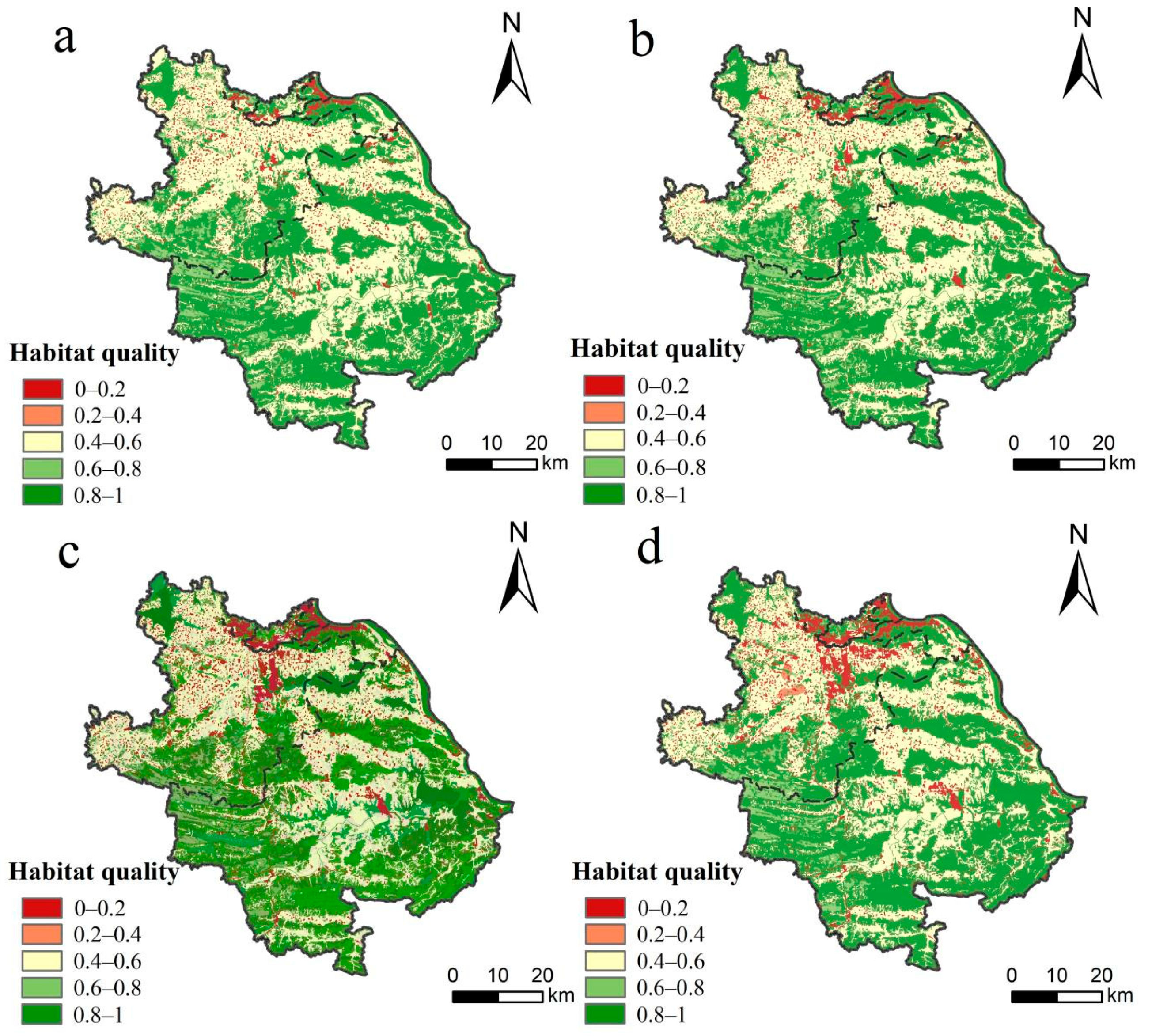
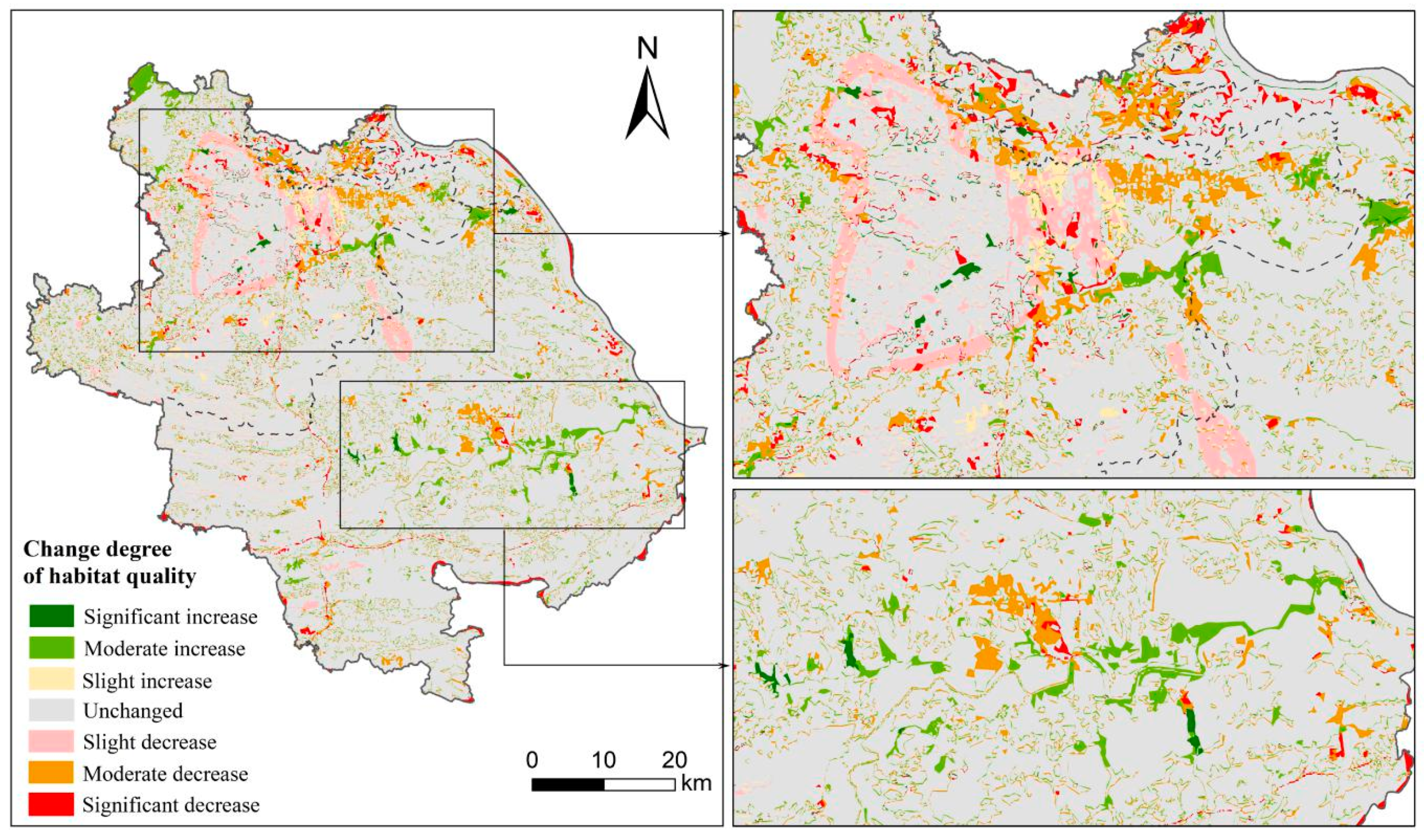
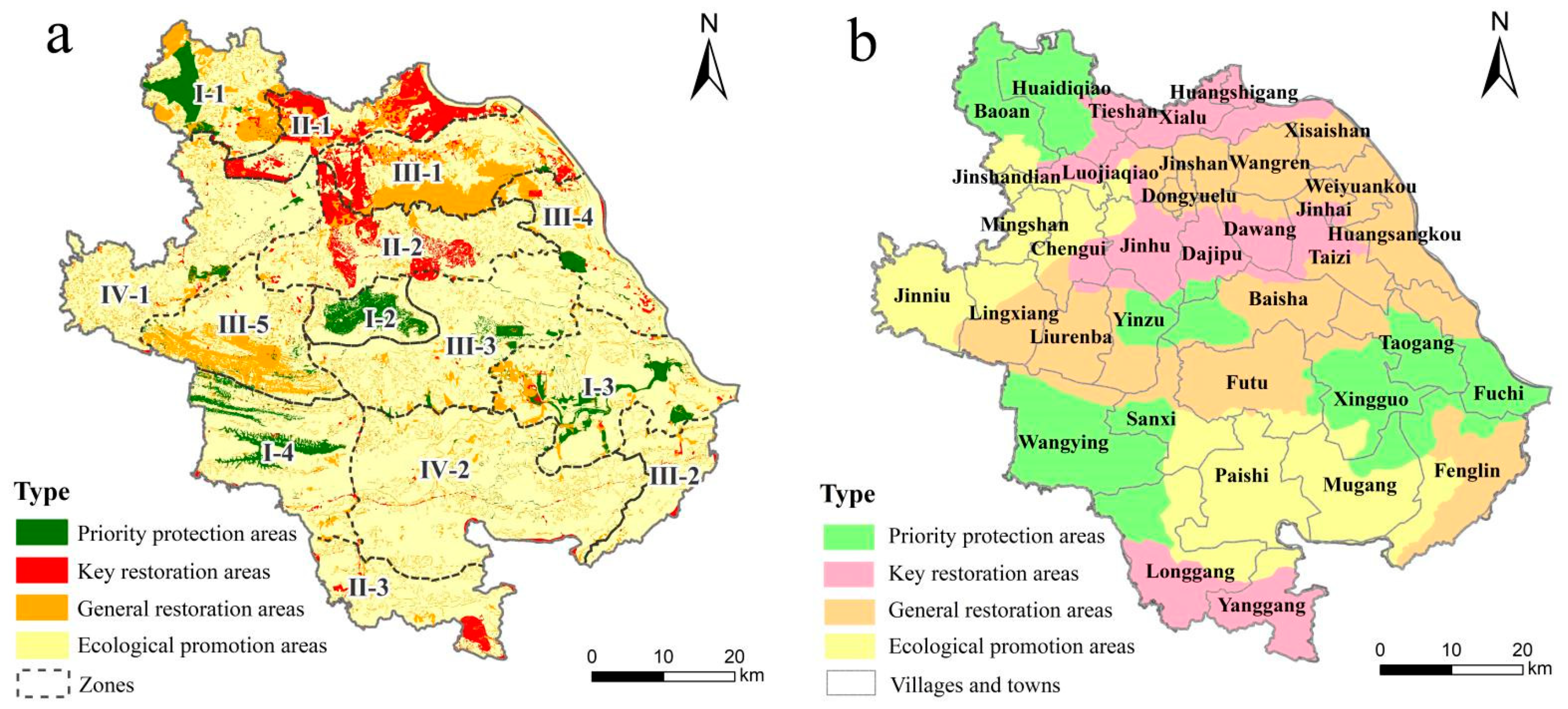
| First-Class Indicators | Second-Class Indicators | Weight | Classification Standards of Ecological Sensitivity | |||
|---|---|---|---|---|---|---|
| Extremely Sensitive | Sensitive | Less Sensitive | Not Sensitive | |||
| Mining | Mine distribution density (mines/km2) | 0.251 | >0.1 | 0.08–0.1 | 0.05–0.08 | <0.05 |
| Mine area (km2) | 0252 | >0.8 | 0.4–0.8 | 0.1–0.4 | <0.1 | |
| Mine management level | 0.249 | Key governance area | General governance area | Other mines | Non-mining area | |
| Type of mining control | 0.248 | Key mining area | Restricted mining area | Mining-prohibited area | Non-mining area | |
| Geological disaster | Geological disaster diversity (hazards/km2) | 0.374 | Strong disaster or multiple disasters | Moderate disaster and multiple disasters | One major disaster that is moderate or below in intensity | Low or underdeveloped |
| Susceptibility | 0.251 | High susceptibility | Moderate susceptibility | Low susceptibility | None | |
| Geological disaster distribution density | 0.375 | >0.5 | 0.1–0.5 | 0.05–0.15 | <0.05 | |
| Biodiversity | Nature reserve level | 0.268 | National nature reserve | Provincial nature reserve | Municipal/county nature reserve | Other regions |
| Wetland buffer distance | 0.343 | <100 m buffer area | 100–200 m buffer area | 200–400 m buffer area | >400 m buffer area | |
| Vegetation type | 0.389 | Arboreal forest | Shrub forest/grassland | Economic forest/farmland | Vegetation-free | |
| Soil erosion | Rainfall erosivity | \ | >600 | 300–600 | 100–300 | <100 |
| Soil erodibility | \ | >0.08 | 0.05–0.08 | 0.03–0.05 | <0.03 | |
| Relief degree of land surface | \ | >300 | 80–300 | 20–80 | <20 | |
| Fractional vegetation cover | \ | >0.7 | 0.4–0.7 | 0.1–0.4 | <0.1 | |
| Threat Factor | Maximum Threat Distance | Weight | Type of Spatial Degradation |
|---|---|---|---|
| Cultivated land | 8 | 0.7 | Linearity |
| Urban land | 10 | 1 | Index |
| Rural residential sites | 5 | 0.6 | Index |
| Mining land | 12 | 1 | Index |
| Roads | 3 | 0.5 | Linearity |
| Name of Land Type | Habitat Suitability | Threat Factor | ||||
|---|---|---|---|---|---|---|
| Cultivated Land | Urban Land | Rural Residential Sites | Mining Land | Roads | ||
| Cultivated land | 0.5 | 0.3 | 0.5 | 0.35 | 0.6 | 0.3 |
| Forests | 1.0 | 0.8 | 0.7 | 0.6 | 0.8 | 0.6 |
| Grassland | 0.9 | 0.5 | 0.4 | 0.7 | 0.4 | 0.6 |
| Water bodies | 1.0 | 0.1 | 0.8 | 0.65 | 1.0 | 0.7 |
| Construction land | 0 | 0 | 0 | 0 | 0 | 0 |
| Unused land | 0.1 | 0.1 | 0.1 | 0.2 | 0.1 | 0.2 |
| Code | Comprehensive Environmental Assessment Zones | Type | Administrative Area |
|---|---|---|---|
| I-1 | Bao’an lake wetland area | Priority protection area | Bao’an town and Haidiqiao town |
| I-2 | Huangpingshan forest area | Priority protection area | Yinzu town and Baisha town |
| I-3 | Wanghu lake wetland area | Priority protection area | Xingguo town, Taogan town, Fuchi town |
| I-4 | Xiandao Lake resort area | Priority protection area | Wangying town, Sanxi town, and Longgang town |
| II-1 | Dazhi iron mine | Key restoration area | Tieshan district, Xialu district, Huangshigang district, Sisaishan district, Jinshandian town |
| II-2 | Dawang mountain-Tiantai mountain-Longfeng mountain reserve | Key restoration area | Daqipu town, Dawang town, Taizi town |
| II-3 | Yangxin marble mine | Key restoration area | Longgang town and Yanggang town |
| III-1 | Dazhi lake drainage basin area | General restoration area | Hekou town, Wangren town, Weiyuankou town |
| III-2 | Fengshan copper mine-Jilong mountain gold and copper mine area | General restoration area | Fenglin town |
| III-3 | Qifengshan ecological park | General restoration area | Baisha town and Futu town |
| III-4 | Eastern river basin integrated area | General restoration area | Huangsangkou town, Fuchi town, Weiyuankou town |
| III-5 | Longfengshan stereoscopic agriculture area | General restoration area | Wangying town and Longgang town |
| IV-1 | Ewangcheng ecological park | Ecological promotion area | Jinniu town, Mingshan township, Chengui town, Lingxiang town |
| IV-2 | Yangxin hill forest area | Ecological promotion area | Mugang town, Paishi town, Sanxi town |
| Code | Comprehensive Environmental Assessment Zones | Preservation and Restoration Measures |
|---|---|---|
| I-1 | Bao’an Lake wetland area | Attach importance to ecological management of river basin and control tourism development in an orderly way. |
| I-2 | Huangpingshan forest area | Strengthen the protection of natural forests, continue to restore natural vegetation, and improve the quality of forests. |
| I-3 | Wanghu Lake wetland area | Strengthen the protection and restoration of the watershed, protect the wetland ecosystem, rare and endangered animals, and plants and their habitats. |
| I-4 | Xiandao Lake resort area | Relying on the current water system, maintain and improve the ecological environment, create tourist resorts, and drive the orderly integration of rural development around lakes. |
| II-1 | Dazhi iron mine | Explore a high-quality mining economic development mode guided by ecological priority and green development, strengthen the level of resource intensive utilization, restrict human activities, and improve the level of land reclamation. |
| II-2 | Dawang Mountain-Tiantai Mountain-Longfeng Mountain reserve | Focus on ecological restoration. Close mountains to cultivate forests, strengthen the restoration of natural vegetation, and maintain the integrity of forest vegetation. At the same time, focus on strengthening soil erosion control, reducing mud-rock flow and hazards, and reducing the incidence of natural hazards. |
| II-3 | Yangxin marble mine | First, efforts should be made to reduce the damaging effects mining and other human activities on the natural ecological system; and the treatment and management of abandoned mines, quarries, and other industrial and mining land should be carried out. Second, implement measures to protect natural forests and restore natural vegetation. |
| III-1 | Dazhi Lake drainage basin area | Focus on the improvement of ecological environment, strengthen the protection of water area, pay attention to the improvement of ecosystem service function, strengthen the construction of green corridor landscape, increase the area of green land, and improve the diversity of vegetation. |
| III-2 | Fengshan copper mine-Jilong Mountain gold and copper mine area | Manage abandoned mines, quarries, and other industrial and mining land; and focus on the control of disasters caused by human engineering activities. |
| III-3 | Qifengshan ecological park | Rationally develop tourism resources and actively develop ecological tourism and economic agriculture and forestry industries. |
| III-4 | Eastern river basin integrated area | Pay attention to watershed ecological management, small watershed management, and restoration of river ecosystems. |
| III-5 | Longfengshan stereoscopic agriculture area | Rationally develop and comprehensively utilize regional tourism resources, focusing on ecological tourism, rural tourism, agricultural processing, and other ecological industries. |
| IV-1 | Ewangcheng ecological park | Protect the farmland, improve low-quality cultivated land, make full use of the rural ecological environment resources, and carry out agricultural tourism with hilly ecological characteristics. |
| IV-2 | Yangxin hill forest area | Starting from the land remediation work, optimize and improve the quality of cultivated land, and strengthen the protection of rural landscape. |
Publisher’s Note: MDPI stays neutral with regard to jurisdictional claims in published maps and institutional affiliations. |
© 2021 by the authors. Licensee MDPI, Basel, Switzerland. This article is an open access article distributed under the terms and conditions of the Creative Commons Attribution (CC BY) license (http://creativecommons.org/licenses/by/4.0/).
Share and Cite
Zhang, C.; Fang, S. Identifying and Zoning Key Areas of Ecological Restoration for Territory in Resource-Based Cities: A Case Study of Huangshi City, China. Sustainability 2021, 13, 3931. https://doi.org/10.3390/su13073931
Zhang C, Fang S. Identifying and Zoning Key Areas of Ecological Restoration for Territory in Resource-Based Cities: A Case Study of Huangshi City, China. Sustainability. 2021; 13(7):3931. https://doi.org/10.3390/su13073931
Chicago/Turabian StyleZhang, Can, and Shiming Fang. 2021. "Identifying and Zoning Key Areas of Ecological Restoration for Territory in Resource-Based Cities: A Case Study of Huangshi City, China" Sustainability 13, no. 7: 3931. https://doi.org/10.3390/su13073931
APA StyleZhang, C., & Fang, S. (2021). Identifying and Zoning Key Areas of Ecological Restoration for Territory in Resource-Based Cities: A Case Study of Huangshi City, China. Sustainability, 13(7), 3931. https://doi.org/10.3390/su13073931







